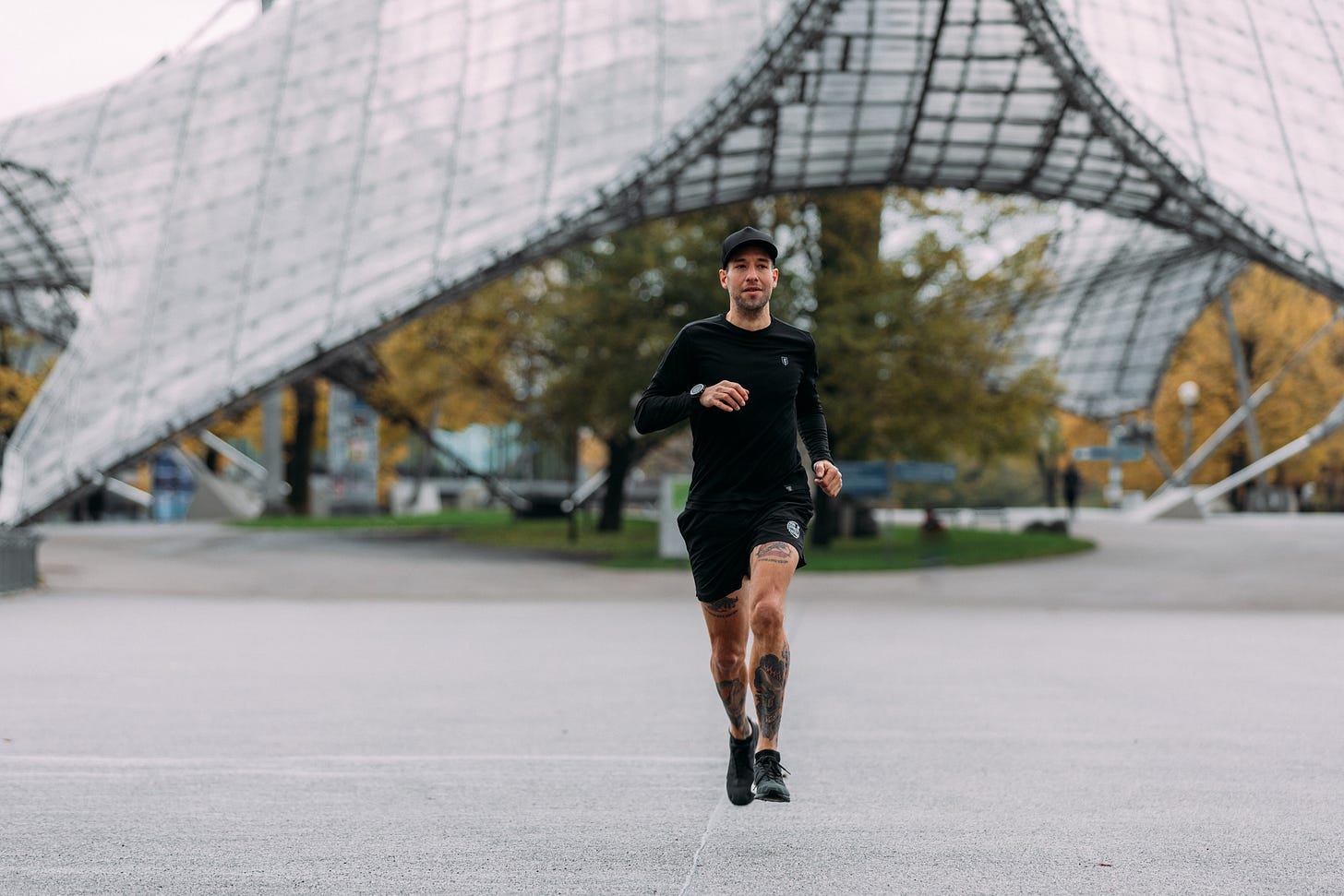A few weeks ago, after unjustifiably complaining about being under-challenged in my marathon training, I received the following message from my coach Karim:
"Speed work will come hard the next weeks."
Spoiler: he delivered.
I've never been able to figure out why a comment like the above gives me goose bumps and instantly boosts my motivation. It's just words, but they do a lot.
Life is easy when you run fast
Yes, I love speedwork. It's totally irrational and goes against every training theory I know, but if I had to choose, I'd do speed sessions 4 times a week all year round. It awakens my body, ignites my spirit, and caresses my soul. When I run fast, it feels like the running Muse is speaking directly to me. Like she is whispering in my ear:
"This is what you have to do. This is who you are."
Despite the pumping lungs, the nagging high heart rate, and the strained muscles, I feel relaxed and clear.
"Life is easy when you run fast."'
(you can quote me anytime)
I feel myself intensely. As I wrote in my "Hart auf Hart" Das Z Letter, I leave the "soft world" we live in when I'm doing speedwork. Everything is real. I can see, smell, hear and feel what is happening with every stride. It's a moment of truth and fulfillment.
Managing discomfort
During a speed workout, I find it much easier to let go of negative thoughts than, say, during an LSD (long slow distance) run. I can handle intense but temporary discomfort much better than less intense but prolonged discomfort. When I notice discomfort, say during a 1000m interval, I calmly acknowledge it, explore where it sits in my body, and look at it as if it were an external object and not a part of me.
Let me be even more specific: for me, the feeling of discomfort starts in my stomach, then as it becomes more intense, it moves up to my lungs and finally, when it really hits hard, to my throat. During speedwork, I consciously and attentively follow my discomfort through its various stations. Without judgment. Without trying to get rid of it. It's a profound moment of self-acceptance, stoically embracing things as they are.
The prime workout
Of course, this magic trick does not work in every speed workout. Usually, it ends at 1000m intervals, maybe 2000m at high intensity if there aren't too many repetitions. If the intervals are longer, I tend to lose control of the situation and negative thoughts hit hard.
Just like yesterday's run. The most intense interval workout I've ever done.
As I mentioned above, my coach Karim has been pushing me hard on speedwork for the last few weeks, and yesterday was the toughest interval workout I've ever had in a training plan:
25 min warm up
Drills & strides
3 x 3000 m at 3:45 min/km with 3 min rest in between
1x 1000 m at 3:40 – 3:35 (I ended up with a 3:27)
15 min cool down
3000 meter intervals. What an Endgegner.
When I discovered this workout on my schedule, I had the impulse to just skip it for the first time in this training cycle. By the way, this was a clear sign that it is time to run this damn marathon and then move on to other running things.
But the Levelhead and the Punk agreed to at least give it a try. After all, we are currently in the prime weeks of my marathon preparation, and skipping such an important core unit would hardly be excusable.
So I tied my shoes, filled my drinking bottle with sugar water and set off for the Olympic Park.
Deep into the training session
After the first half of the first 3000m interval I had the plausible thought that maybe running is not the right hobby for me and that I should look for a more relaxing leisure activity.
I was having a lot of trouble keeping up with the pace, my body (or rather my mind?) was resisting any real effort. I probably hadn't fully processed the last speedwork – 10x 1000 m – yet. That was only 2 days ago. I felt uncomfortable and negative thoughts dominated:
"Your form curve is going down, not up."
"You're overtraining."
"You should have known you couldn't do these back-to-back threshold sessions."
"Now you're paying the price for missing rest days."
And so on and so on.
Despite the negative thought spirals, I pushed through this grueling 3000m interval. Three minutes of trotting goes by quickly when you're training on your threshold and gasping for air. So, in the blink of an eye, I found myself in the second interval, which strangely felt much less threatening and immediately triggered positive thoughts instead of negative ones:
"Cool! If you've done this, you're already more than halfway there!"
"You just need to repeat what you just did."
"Your legs can do this, they feel great!"
"Look at that duck!"
I felt my body straighten up and my stride lengthen. Suddenly, 3000m at a 3:45 pace was perfectly doable and didn't feel all that bad. The same was true for the third interval. And when the crowning glory was a single 1000m, I was in such a high-spirited mood that I ran with a giant grin on my face, celebrating every step of this ridiculously short interval.
The subsequent cool-down felt like a victory parade through a city liberated from war occupation, even though nobody waved at me and threw flowers on my tank.
My mood was so good that I could even forgive the asshole who not only kicked over my water bottle, but also stomped on it and broke the cap. But I didn't need to drink any more because the toughest speed session of my running life so far was over.
What a feeling of elation. Why do we run? Because of this.
Disclaimer: My fast is someone else's slow and vice versa. I always get a bad feeling in my stomach when I write about training sessions and provide numbers and data. We runners tend to compare ourselves to others, and I never want my writing to cause negative feelings in others. I will be publishing a special Das Z Letter about this in the coming days to explain in more detail what I mean. Until then, just replace the numbers in this article with ones that fit your training and running world and make you feel understood and supported. Because that's my goal.
Everything not running
I have expanded the distribution network for my book a bit. In addition to a few smaller, lesser-known bookshops, “Runhundred” is now available on Apple Books.
This is a great move for me, as I've been totally immersed in the Apple universe for almost 20 years. Don't worry, there won't be a block of ads for the book or the new iPhone, but let me just say two words about Apple.
To think clearly, to be creative, to enjoy working, to want to create and to be able to create, my tools have to function. That's right, they have to function. Nothing more, nothing less. This is the case with Apple products, both hardware and software. Not all the time. Not everything. But a lot more often than in the Microsoft hell I spent my life in before.
What I want – no, what I need – are low-threshold, highly usable, seamlessly integrated devices and applications that sit quietly in the background while I'm working. Or to put it another way: I would rather not focus on the tools when I'm working, I want to focus on the work I'm doing with them.
I think every hardware and software manufacturer has an obligation to put the user at the centre in this way. It's the company's duty to deliver, not the user's. Apple does that. Not all the time. Not everything. But more, better and more often than anyone else. Please tell me if you disagree.








Es gibt im Training wenig Befriedigenderes als das Gefühl, wenn die Form ansteigt - so, als würde Dich jemand von hinten mit anschieben. I love speedwork, too!
Ich kann das Gefühl der Apple Welt total nachvollziehen. Also ich vom Samsung Galaxy ACE 2 2010 total enttäuscht wurde, holte ich das 5C als mein erstes iPhone.
Seit dem bin ich im Universum hängen geblieben. Selbst mein iPad Pro von 2017 kann ich noch als zweiten Bildschirm bei meinem MacBook Pro (2020) nutzen.
Kann dort beginnen mit Predigt schreiben, habe ich unterwegs Idee ergänze ich über das iPhone und lese übers Pad Korrektur
Auch Training daheim mit Fitness+ Option für Regentage.
Und ja, selbst die Ultra 2 leistet mir auf den Rennen die ich laufe (Straße <22km) und beim wandern gute Dienste